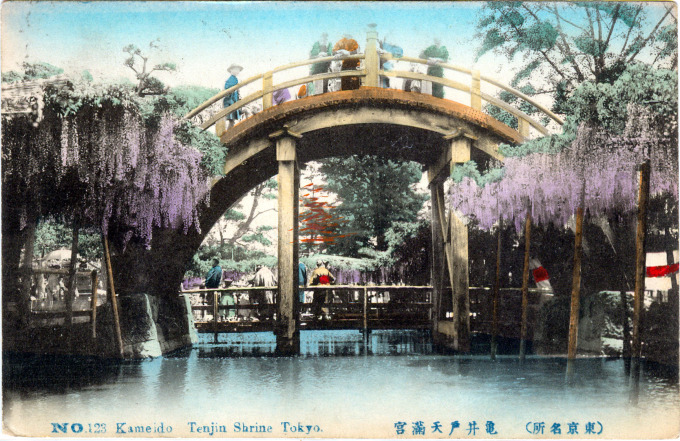See also:
Wisteria Blossoms at Kameido, c. 1910
“Kameido, with its Shrine and Wistaria Garden, in Honjo-ku, in a tawdry neighborhood near the NE outskirts of the city, should be visited in late April or early May as the wistaria usually begin to droop about the end of the first week in May. The narrow thoroughfare leading to the entrance terminates in a handsomely carved gateway in the natural wood adorned with shishi, fishes, birds, dragons, and wave patterns.
“Just within the inclosure [sic] is a locally celebrated Drum Bridge (Taiko bashi), a time-worn structure over whose high hump devotees climb (risky with high-heeled shoes) as an act of special devotion to the divinity to whom the shrine is consecrated.
“… The name Kameido is said to be derived from kamei (lit., sitting like a tortoise with the feet spread out behind) wherefore the big stone tortoise which the visitor will note a few yards to the right of the temple. Some pretty bridges span the narrowest parts of the pond and many graceful trees overshadow it.”
– Terry’s Japanese Empire, by Thomas Philip Terry, 1914
From the wiki: “The Tenjin shrine network enshrines 9th-century scholar Sugawara no Michizane. Sugawara had originally been enshrined to placate his spirit, not to be worshiped. He had been unjustly been exiled in his life, and it was therefore necessary to somehow placate his rage, believed to be the cause of a plague and other disasters.
“Tokyo’s Kameido Tenjin Shrine is perhaps most well-known for two things: its famous arched ‘drum bridge’ and the purple wisteria which overhang much of its ponds from overhead trellises. The spacious grounds of Kameido Shrine are dedicated to the 9th century scholar, poet, and politician named Sugawara no Michizane.
“The Kameido Shrine of Tokyo itself dates to 1662, when a statue of Michizane made from plum wood (this was Michizane’s favorite tree) was installed here in his honor. Since then, Kameido has remained a popular destination for Japanese worshippers of the Japanese Edo, Meiji, Taisho, Showa, and now Heisei periods.”



Pingback: Wisteria Blossoms at Kameido, c. 1910. | Old Tokyo
Pingback: Matsuya (Asakuksa) Department Store & Tobu Railway, c. 1930. | Old Tokyo
Pingback: “Year of the Rabbit (Hare)”, New Year’s postcard, 1939. | Old TokyoOld Tokyo